Spatial Assessment of Water Quality with Urbanization in 2007–2015, Shanghai, China
Abstract
1. Introduction
2. Materials and Methodology
2.1. Study Area
2.2. Data
2.3. Methodology
3. Results and Discussion
3.1. Classification and Urban Area Changes
3.2. Urban Index
3.3. Water Quality Patterns and Urbanization Impacts
4. Conclusions
Author Contributions
Funding
Acknowledgments
Conflicts of Interest
References
- World Resource Institute. 2007. Available online: http://www.wri.org/publication/wri-annualreport-2006–2007 (accessed on 21 April 2015).
- Bao, L.J.; Maruya, K.A.; Snyder, S.A.; Zeng, E.Y. China’s water pollution by persistent organic pollutants. Environ. Pollut. 2012, 163, 100–108. [Google Scholar] [CrossRef] [PubMed]
- Li, H.; Li, Y.; Lee, M.K.; Liu, Z.; Miao, C. Spatiotemporal analysis of heavy metal water pollution in transitional China. Sustainability 2015, 7, 9067–9087. [Google Scholar] [CrossRef]
- Li, Y.; Li, H.; Liu, Z.; Miao, C. Spatial Assessment of Cancer Incidences and the Risks of Industrial Wastewater Emission in China. Sustainability 2016, 8, 480. [Google Scholar] [CrossRef]
- Zhang, R.; Hamerlinck, J.D.; Gloss, S.P.; Munn, L. Determination of Nonpoint-Source Pollution Using GIS and Numerical Models. J. Environ. Qual. 1996, 25, 411–418. [Google Scholar] [CrossRef]
- Ebenstein, A. The consequences of industrialization: Envidence from water pollution and digestive cancers in China. Rev. Econ. Stat. 2012, 94, 186–201. [Google Scholar] [CrossRef]
- Yin, Z.Y.; Walcott, S.; Kaplan, B.; Cao, J.; Lin, W.; Chen, M.; Liu, D.; Ning, Y. An analysis of the relationship between spatial patterns of water quality and urban development in Shanghai, China. Comput. Environ. Urban Syst. 2005, 29, 197–221. [Google Scholar] [CrossRef]
- Zhao, S.; Da, L.; Tang, Z.; Fang, H.; Song, K.; Fang, J. Ecological consequences of rapid urban expansion: Shanghai, China. Front. Ecol. Environ. 2006, 4, 341–346. [Google Scholar] [CrossRef]
- Zhang, H. The orientation of water quality variation from the metropolis river–Huangpu River, Shanghai. Environ. Monit. Assess. 2007, 127, 429–434. [Google Scholar] [CrossRef] [PubMed]
- Wang, J.; Da, L.; Song, K.; Li, B.L. Temporal variations of surface water quality in urban, suburban and rural areas during rapid urbanization in Shanghai, China. Environ. Pollut. 2008, 152, 387–393. [Google Scholar] [CrossRef] [PubMed]
- Jiang, L.; Hu, X.; Yin, D.; Zhang, H.; Yu, Z. Occurrence, distribution and seasonal variation of antibiotics in the Huangpu River, Shanghai, China. Chemosphere 2011, 82, 822–828. [Google Scholar] [CrossRef] [PubMed]
- Jiang, L.; Hu, X.; Xu, T.; Zhang, H.; Sheng, D.; Yin, D. Prevalence of antibiotic resistance genes and their relationship with antibiotics in the Huangpu River and the drinking water sources, Shanghai, China. Sci. Total Environ. 2013, 458, 267–272. [Google Scholar] [CrossRef] [PubMed]
- China Statistical Yearbook, Shanghai, China. The Central People’s Government of the People’s Republic of China, The People’s Republic of China Yearbook. 2015. Available online: http://www.gov.cn/test/2005-07/27/content_17403.htm (accessed on 13 July 2015).
- Li, H.; Wang, C.; Jiang, Y.; Hug, A.; Li, Y. Spatial assessment of sewage discharge with urbanization in 2004–2014, Beijing, China. AIMS Environ. Sci. 2016, 3, 842–857. [Google Scholar] [CrossRef]
- Coskun, H.G.; Gulergun, O.; Yilmaz, L. Monitoring of protected bands of Terkos drinking water reservoir of metropolitan Istanbul near the Black Sea coast using satellite data. Int. J. Appl. Earth Obs. Geoinf. 2006, 8, 49–60. [Google Scholar] [CrossRef]
- Asadi, S.S.; Vuppala, P.; Anji Reddy, M. Remote Sensing and GIS Techniques for Evalution of Groundwater Quality in Municipal Corporation of Hyderabad (Zone-V), India. Int. J. Environ. Res. Public Health 2007, 4, 45–52. [Google Scholar] [CrossRef] [PubMed]
- Satapathy, D.R.; Salve, P.R.; Katpatal, Y.B. Spatial distribution of metals in ground/surface waters in the Chandrapur district (Central India) and their plausible sources. Environ. Geol. 2009, 56, 1323–1352. [Google Scholar] [CrossRef]
- Dede, O.T.; Telci, I.T.; Aral, M.M. The use of water quality index models for the evaluation of surface water quality: A case study for Kirmir Basin, Ankara, Turkey. Water Qual. Expos. Health 2013, 5, 41–56. [Google Scholar]
- Wang, M.; Webber, M.; Finlayson, B.; Barnett, J. Rural industries and water pollution in China. J. Environ. Manag. 2008, 86, 648–659. [Google Scholar] [CrossRef] [PubMed]
- Foster, J.A.; McDonald, A.T. Assessing pollution risks to water supply intakes using geographical information systems (GIS). Environ. Model. Softw. 2000, 15, 225–234. [Google Scholar] [CrossRef]
- Yang, T.; Liu, J. Health Risk Assessment and Spatial Distribution Characteristic on Heavy Metals Pollution of Haihe River Basin. J. Environ. Anal. Toxicol. 2012, 2, 152. [Google Scholar] [CrossRef]
- Wang, Y.; Wang, P.; Bai, Y.; Tian, Z.; Li, J.; Shao, X.; Mustavich, L.F.; Li, B.L. Assessment of surface water quality via multivariate statistical techniques: A case study of the Songhua River Harbin region, China. J. Hydro-Environ. Res. 2013, 7, 30–40. [Google Scholar] [CrossRef]
- Soil and Water Assessment Tool (SWAT). 2012. Available online: http://swat.tamu.edu/ (accessed on 27 June 2016).
- Zhang, J.; Mauzerall, D.; Zhu, T.; Liang, S.; Ezzati, M.; Remais, J.V. Environmental health in China: Progress towards clean air and safe water. Lancet 2010, 375, 1110–1119. [Google Scholar] [CrossRef]
- Liu, Q.; Xie, W.; Xia, J. Using Semivariogram and Moran’s I Techniques to Evaluate Spatial Distribution of Soil Micronutrients. Commun. Soil Sci. Plant Anal. 2013, 44, 1182–1192. [Google Scholar] [CrossRef]
- Lee, C.C.; Chiu, Y.B.; Sun, C.H. The environmental Kuznets curve hypothesis for water pollution: Do regions matter? Energy Policy 2010, 38, 12–23. [Google Scholar] [CrossRef]
- Liu, J.; Zhang, X.; Tran, H.; Wang, D.Q.; Zhu, Y.N. Heavy metal contamination and risk assessment in water, paddy soil, and rice around an electroplating plant. Environ. Sci. Pollut. Res. 2011, 18, 1623–1632. [Google Scholar] [CrossRef] [PubMed]
- Schwarzenbach, R.P.; Egli, T.; Hofstetter, T.B.; Von Gunten, U.; Wehrli, B. Global water pollution and human health. Annu. Rev. Environ. Resour. 2010, 35, 109–136. [Google Scholar] [CrossRef]
- He, H.; Zhou, J.; Wu, Y.; Zhang, W.; Xie, X. Modelling the response of surface water quality to the urbanization in Xi’an, China. J. Environ. Manag. 2008, 86, 731–749. [Google Scholar] [CrossRef] [PubMed]
- Ren, W.; Zhong, Y.; Meligrana, J.; Anderson, B.; Watt, W.E.; Chen, J.; Leung, H.L. Urbanization, land use, and water quality in Shanghai: 1947–1996. Environ. Int. 2003, 29, 649–659. [Google Scholar] [CrossRef]
- Wu, S.S.; Qiu, X.; Wang, L. Population estimation methods in GIS and remote sensing: A review. GIScience Remote Sens. 2005, 42, 80–96. [Google Scholar] [CrossRef]
- Cui, L.; Shi, J. Urbanization and its environmental effects in Shanghai, China. Urban Clim. 2012, 2, 1–15. [Google Scholar] [CrossRef]
- Li, J.J.; Wang, X.R.; Wang, X.J.; Ma, W.C.; Zhang, H. Remote sensing evaluation of urban heat island and its spatial pattern of the Shanghai metropolitan area, China. Ecol. Complex. 2009, 6, 413–420. [Google Scholar] [CrossRef]
- Chen, S.; Zeng, S.; Xie, C. Remote sensing and GIS for urban growth analysis in China. Photogramm. Eng. Remote Sens. 2000, 66, 593–598. [Google Scholar]
- Wei, C.; Taubenböck, H.; Blaschke, T. Measuring urban agglomeration using a city-scale dasymetric population map: A study in the Pearl River Delta, China. Habitat Int. 2017, 59, 32–43. [Google Scholar] [CrossRef]
- Alexander, R.B.; Boyer, E.W.; Smith, R.A.; Schwarz, G.E.; Moore, R.B. The role of headwater streams in downstream water quality. JAWRA J. Am. Water Resour. Assoc. 2007, 43, 41–59. [Google Scholar] [CrossRef] [PubMed]
- United States Geological Survey. 2008. Available online: http://earthexplorer.usgs.gov/ (accessed on 13 July 2015).
- China Data Center. 2015. Available online: https://chinadatacenter.org/ (accessed on 27 January 2015).
- Quality Standard for Ground Water. 2002. Available online: http://g2g.tx.gov.cn/art/2015/10/13/art_97_53143.html (accessed on 5 December 2015). (In Chinese).
- Zang, C.; Huang, S.; Wu, M.; Du, S.; Scholz, M.; Gao, F.; Lin, C.; Guo, Y.; Dong, Y. Comparison of relationships between pH, dissolved oxygen and chlorophyll a for aquaculture and non-aquaculture waters. Water Air Soil Pollut. 2011, 219, 157–174. [Google Scholar] [CrossRef]
- Xie, J.; Liu, H.; Wang, A. The role of ammonia nitrogen, total nitrogen, trinitrogen conversion, and ammonia nitrogen in water pollution assessment and control. Inner Mong. Water Resour. 2011, 5, 34–36. (In Chinese) [Google Scholar]
- Li, Z.; Zhong, Z. Analysis of the relationship among BOD, chemical oxygen demand, and permanganate index. Tech. Superv. Water Resour. 2015, 23, 5–6. (In Chinese) [Google Scholar]
- Murphy, R.R.; Curriero, F.C.; Ball, W.P. Comparison of spatial interpolation methods for water quality evaluation in the Chesapeake Bay. J. Environ. Eng. 2009, 136, 160–171. [Google Scholar] [CrossRef]
- Fundamentals of Environmental Measurements. Available online: http://www.fondriest.com/environmental-measurements/ (accessed on 27 January 2015).
- McCutcheon, S.C.; Martin, J.L.; Barnwell, T.O. Water quality. Handb. Hydrol. 1993, 11, 73. [Google Scholar]
- Viessman, W.; Hammer, M.J.; Perez, E.M.; Chadik, P. Water Supply and Pollution Control; Pearson Prentice Hall: Upper Saddle River, NJ, USA, 2009. [Google Scholar]
- International Organization for Standardization: Water Quality—Determination of Permanganate Index. 1993. Available online: https://www.iso.org/standard/15669.html (accessed on 5 December 2016).
- Tucker, C.S.; Boyd, C.E. Relationships between potassium permanganate treatment and water quality. Trans. Am. Fisheries Soc. 1977, 106, 481–488. [Google Scholar] [CrossRef]
- Kannel, P.R.; Lee, S.; Lee, Y.S.; Kanel, S.R.; Khan, S.P. Application of water quality indices and dissolved oxygen as indicators for river water classification and urban impact assessment. Environ. Monit. Assess. 2007, 132, 93–110. [Google Scholar] [CrossRef] [PubMed]
- Shanghai Environmental Protection Bureau. 2010. Available online: http://www.sepb.gov.cn/fa/cms/upload/uploadFiles/2011-11-09/file675.pdf (accessed on 5 December 2016).
- Li, X.; Manman, C.; Anderson, B.C. Design and performance of a water quality treatment wetland in a public park in Shanghai, China. Ecol. Eng. 2009, 35, 18–24. [Google Scholar] [CrossRef]
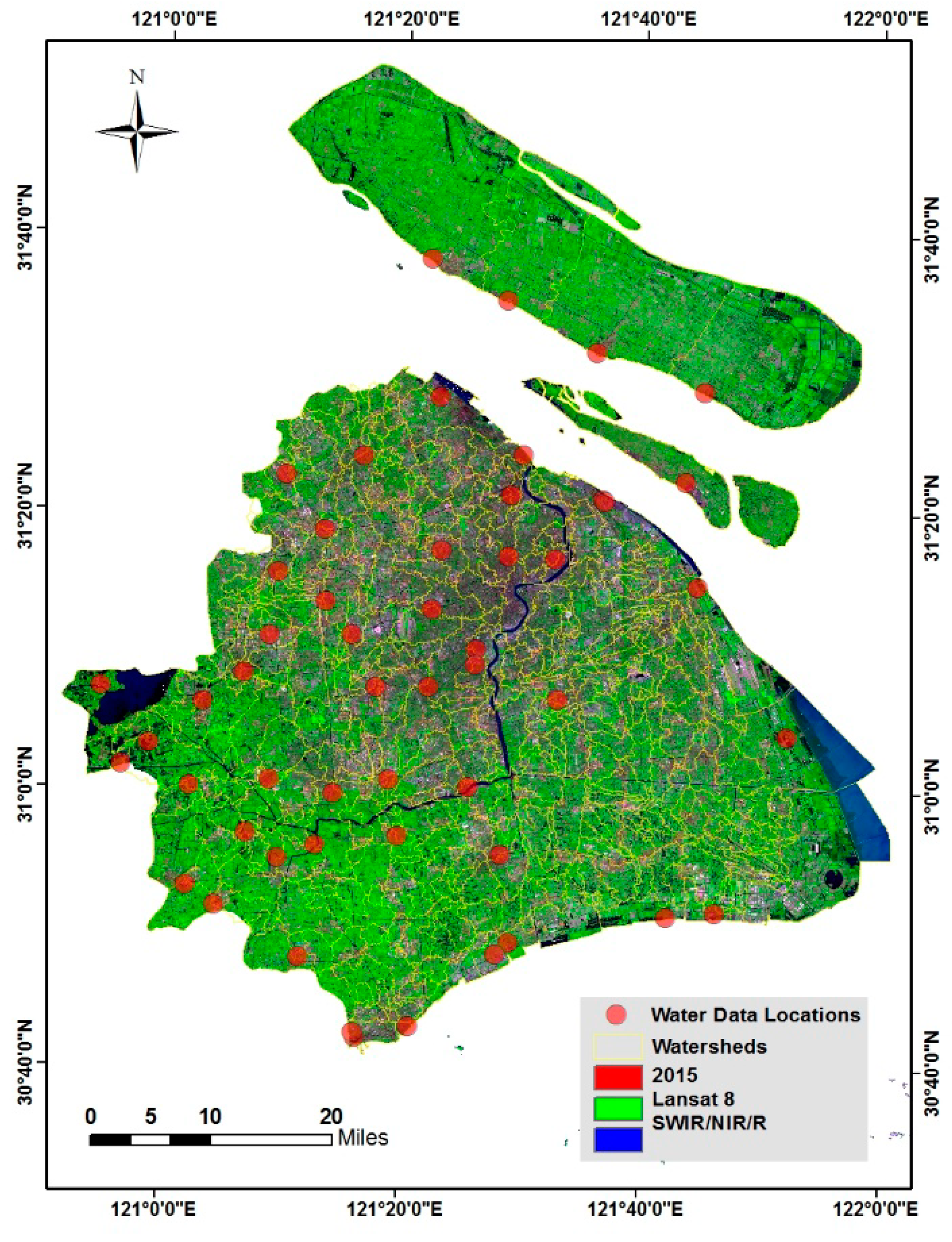
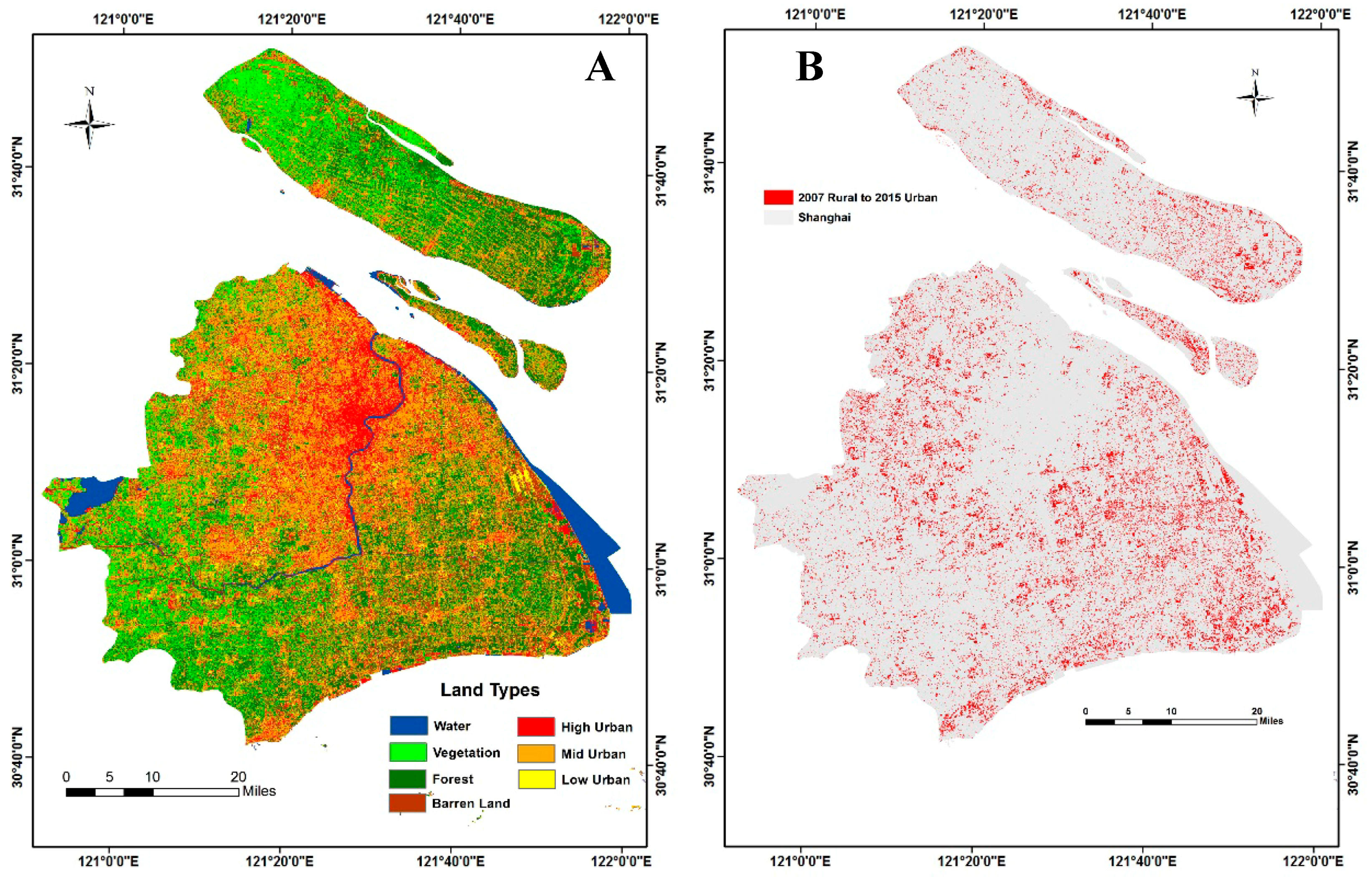
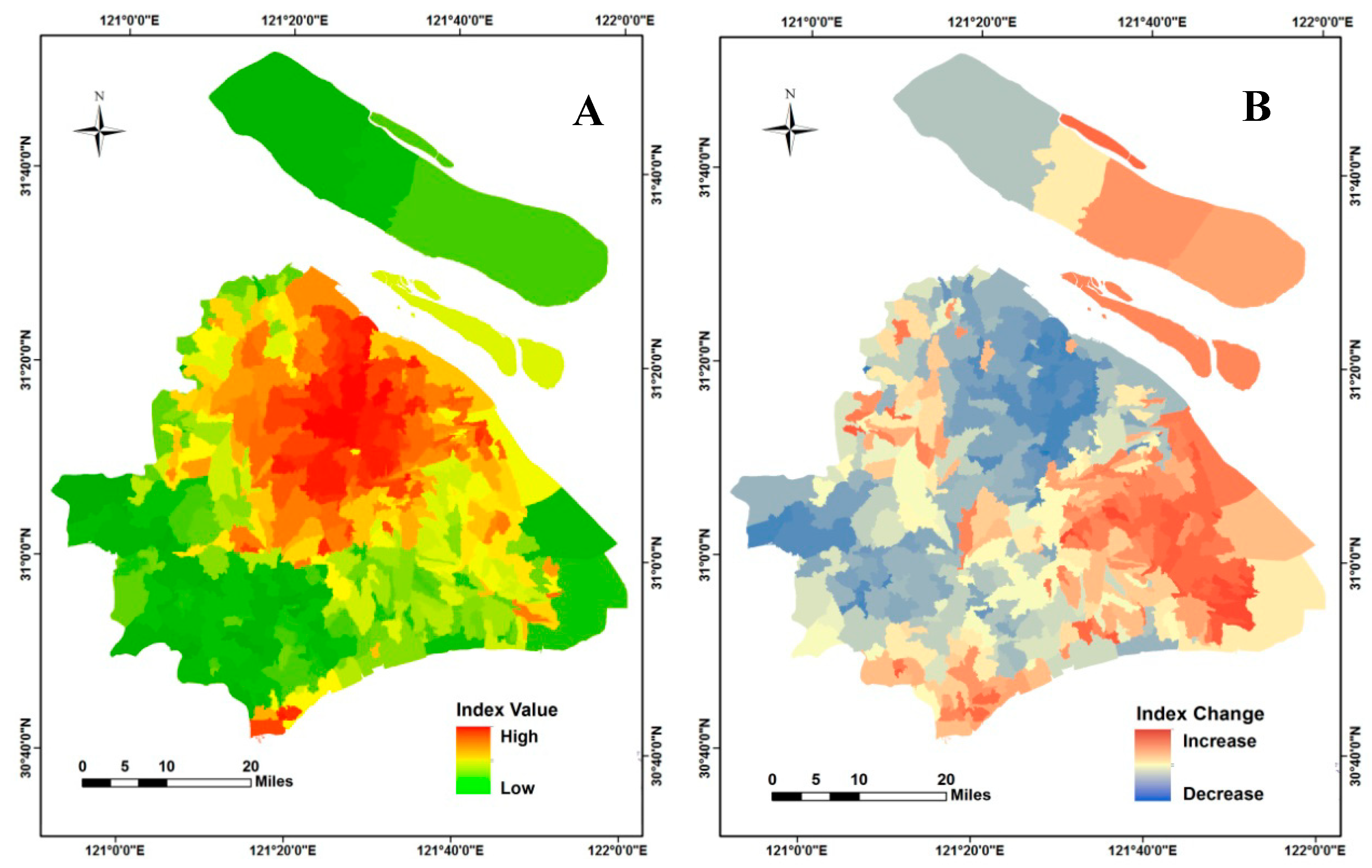
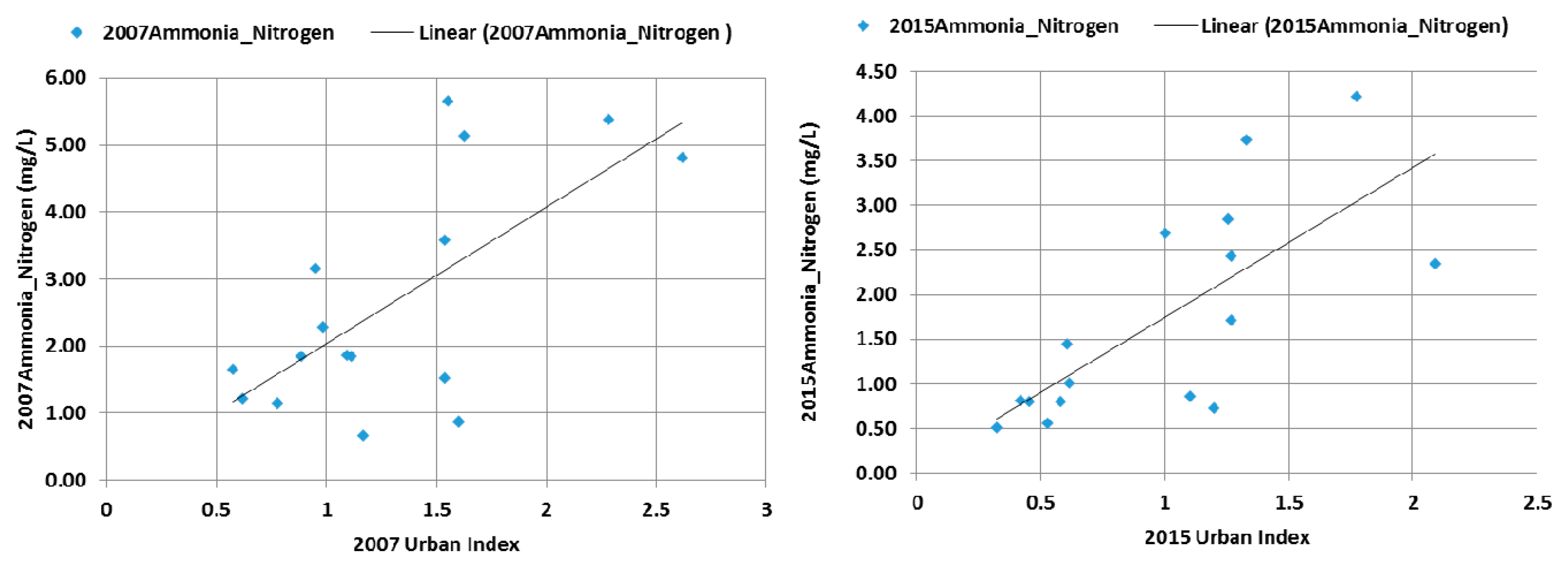
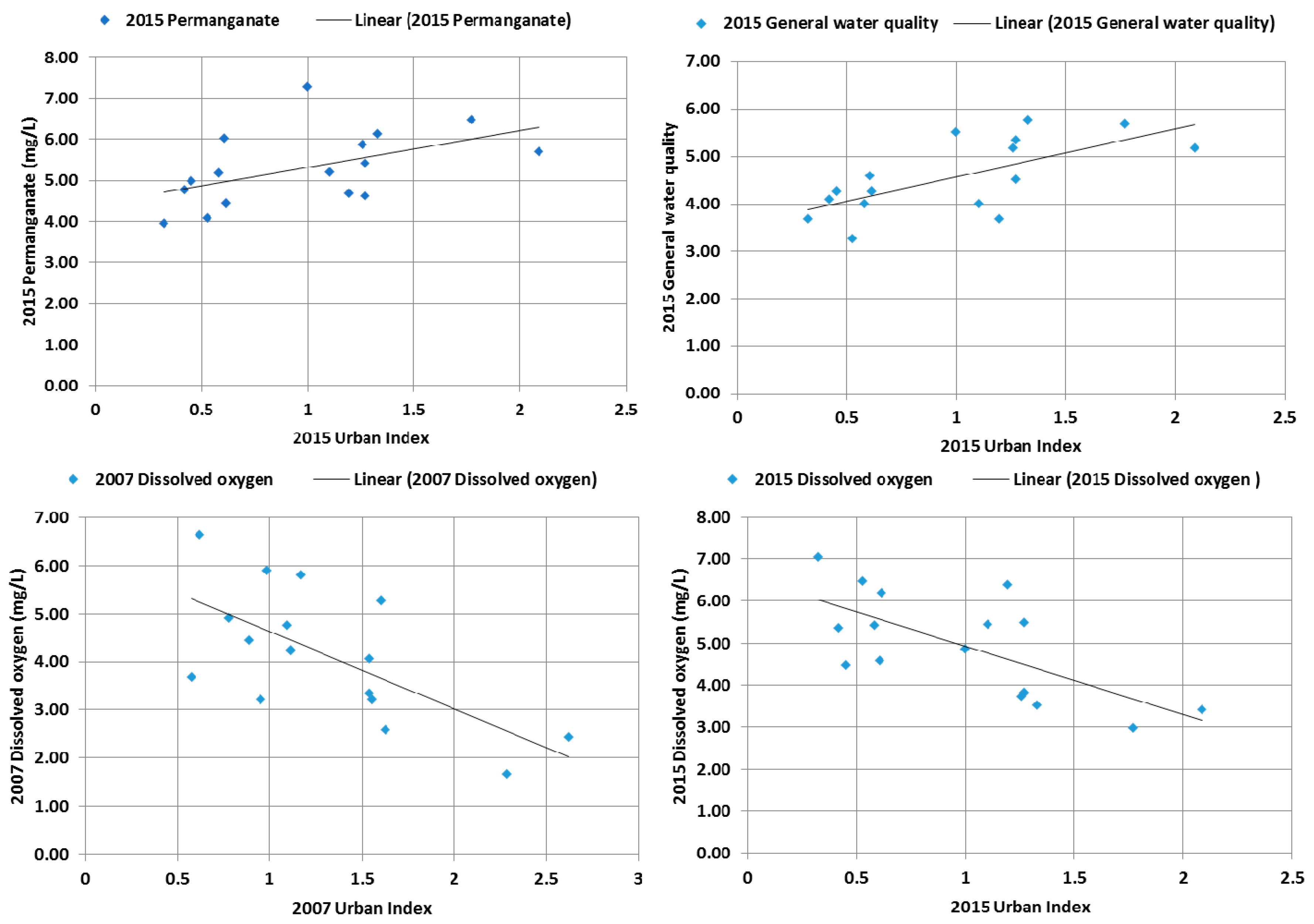
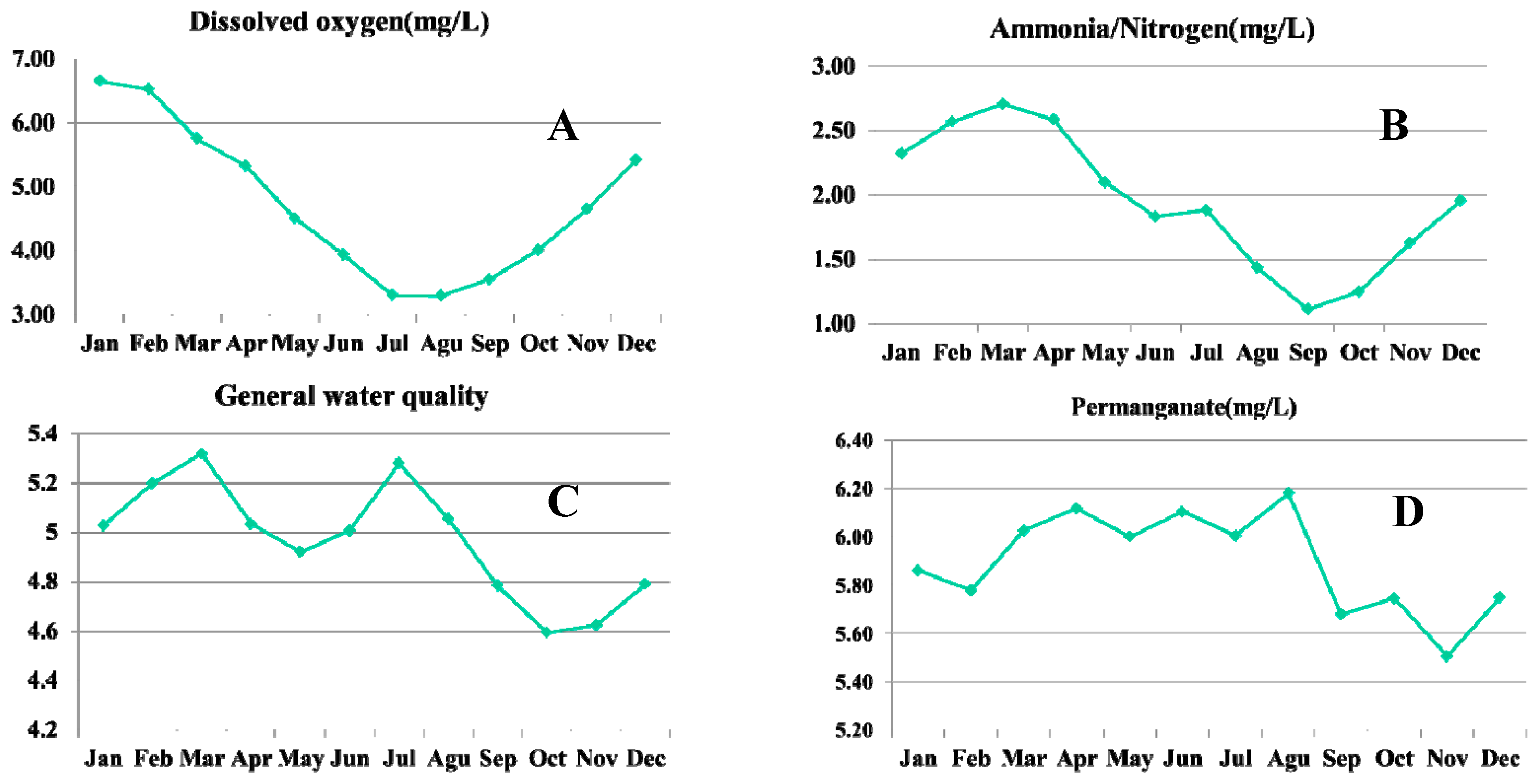
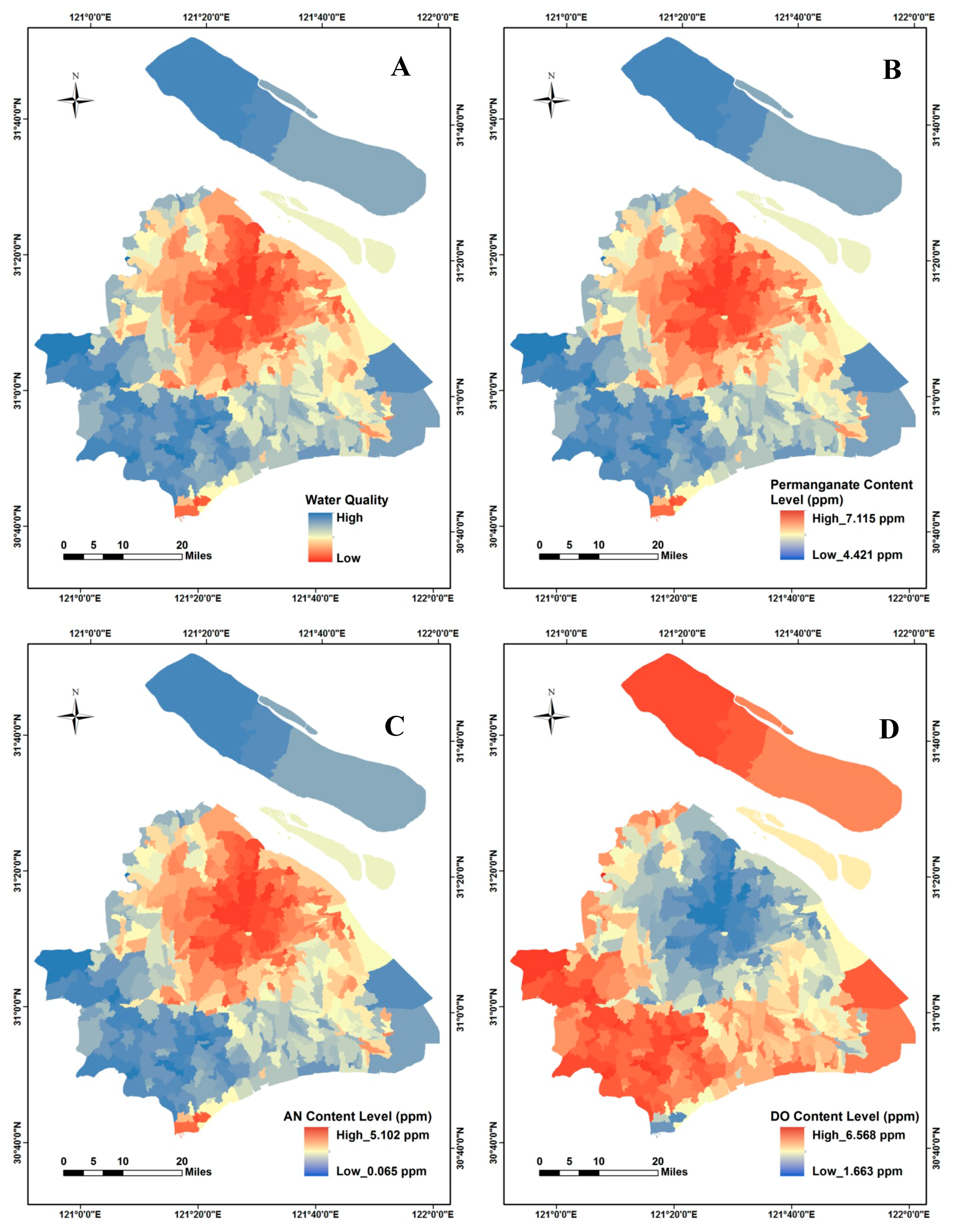
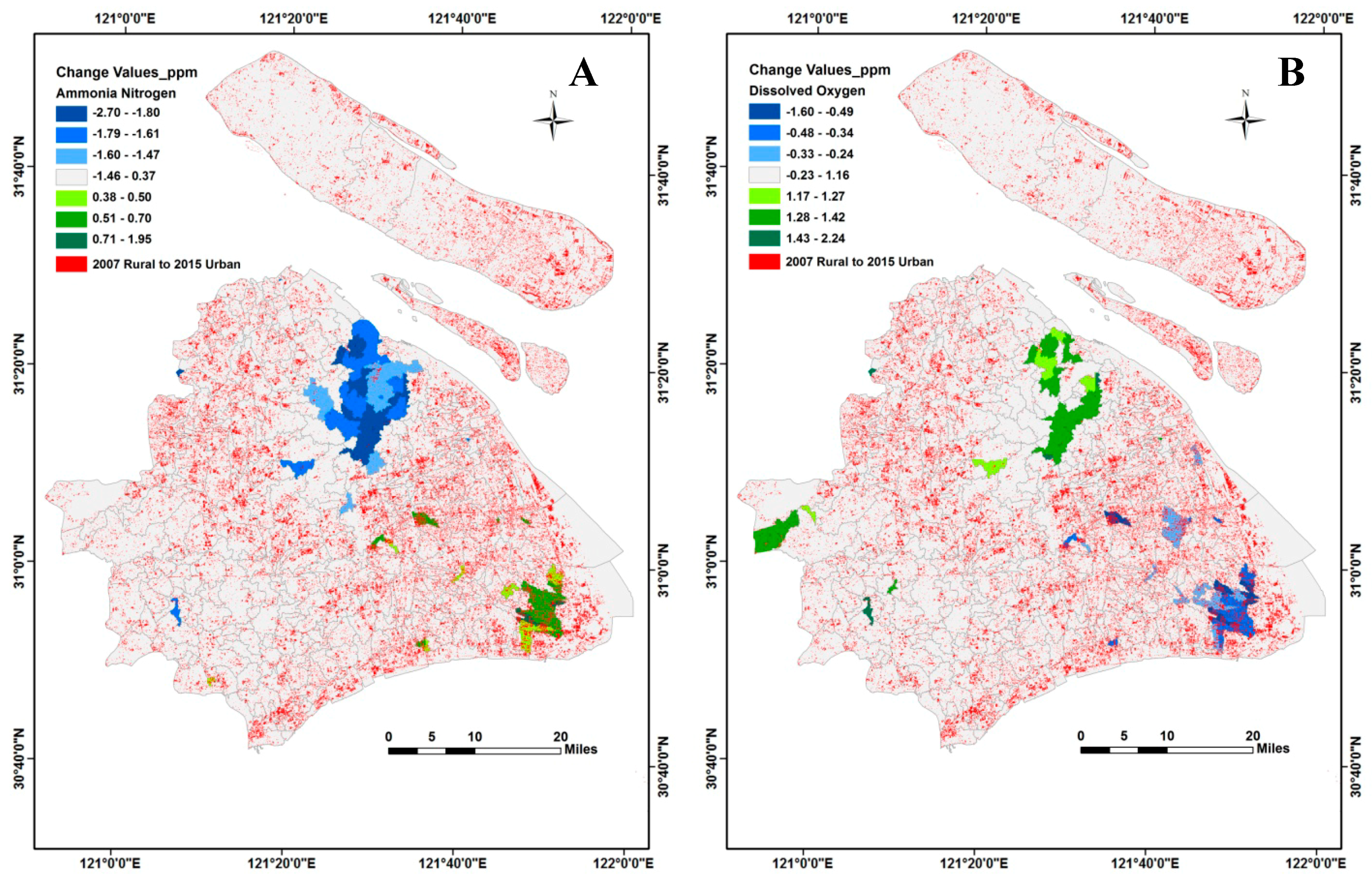
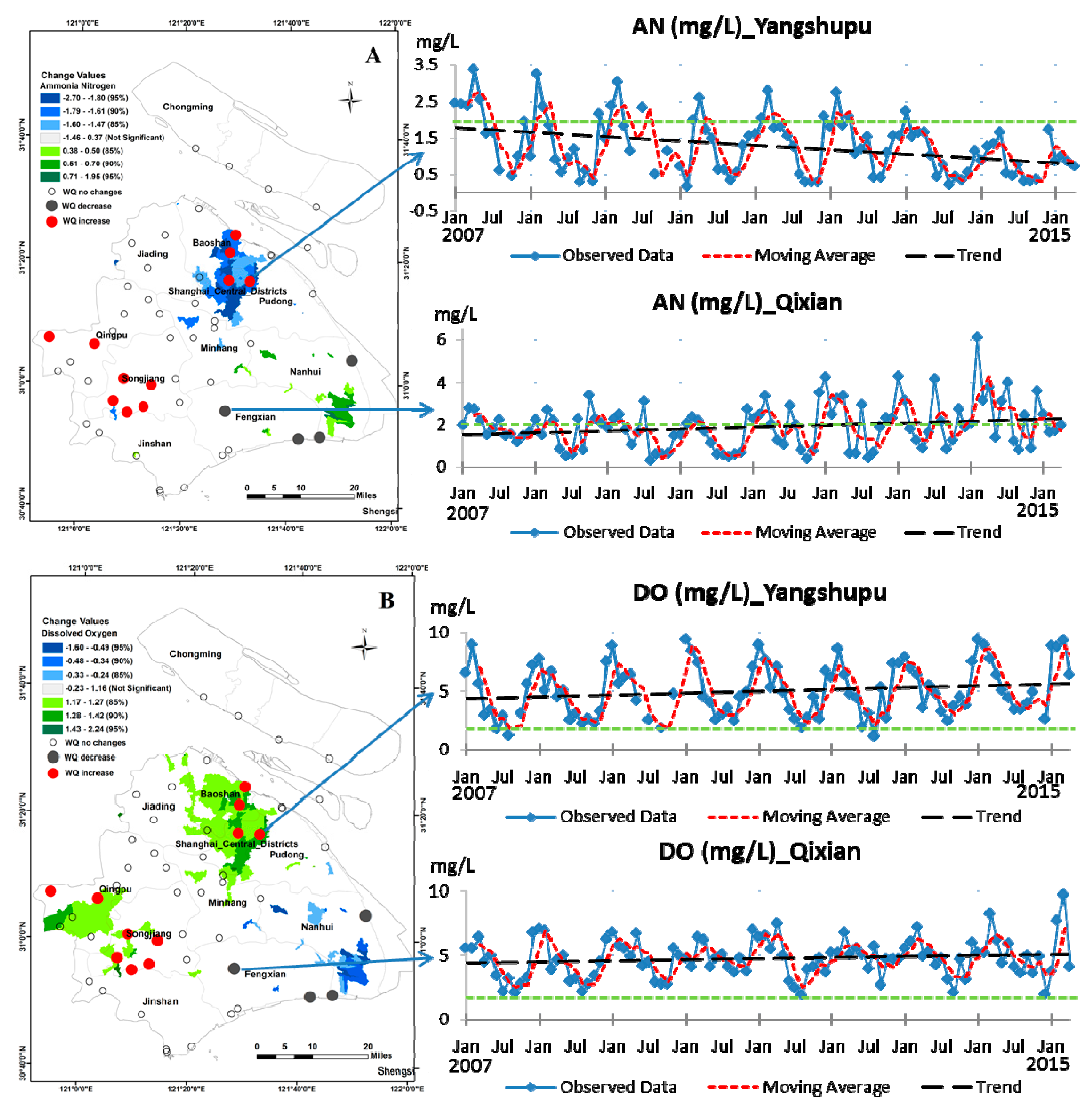
| Water Quality | Excellent | Good | Slightly Polluted | Polluted | Severely Polluted | |
|---|---|---|---|---|---|---|
| General Water Quality Class | I | II | III | IV | V | |
| Dissolved Oxygen | ≥ | Saturation rate 90% or 7.5 | 6 | 5 | 3 | 2 |
| Permanganate Index | ≤ | 2 | 4 | 6 | 10 | 15 |
| Ammonia Nitrogen | ≤ | 0.15 | 0.5 | 1.0 | 1.5 | 2.0 |
| Class | Truth Points | Producer Accuracy | Omission Error | User’s Accuracy | Commission Error | Conditional Kappa |
|---|---|---|---|---|---|---|
| Water | 13 | 100% | 0% | 100% | 0% | 1 |
| Forest | 59 | 100% | 0% | 85% | 15% | 0.81 |
| Bare soil | 28 | 93% | 7% | 100% | 0% | 1 |
| Agricultural land | 51 | 86% | 14% | 100% | 0% | 1 |
| Low urban | 17 | 81% | 19% | 100% | 0% | 1 |
| Medium urban | 62 | 100% | 0% | 92% | 8% | 0.90 |
| High urban | 20 | 100% | 0% | 100% | 0% | 1 |
| Overall Accuracy | 94.40% | |||||
| Overall Kappa | 0.93 | |||||
| Class | Truth Points | Producer Accuracy | Omission Error | User’s Accuracy | Commission Error | Conditional Kappa |
|---|---|---|---|---|---|---|
| Water | 21 | 100% | 0% | 100% | 0% | 1 |
| Forest | 74 | 97% | 3% | 89% | 11% | 0.85 |
| Bare soil | 17 | 100% | 0% | 88% | 12% | 0.87 |
| Agricultural land | 38 | 80% | 20% | 97% | 3% | 0.97 |
| Low urban | 24 | 81% | 19% | 88% | 12% | 0.86 |
| Medium urban | 48 | 96% | 4% | 98% | 2% | 0.97 |
| High urban | 28 | 96% | 4% | 86% | 14% | 0.84 |
| Overall Accuracy | 92.4% | |||||
| Overall Kappa | 0.91 | |||||
| General Water Quality | Dissolved Oxygen | Ammonia Nitrogen | Permanganate Index | |||||
|---|---|---|---|---|---|---|---|---|
| 2007 UI | 0.27 | −0.66 ** | 0.67 ** | 0.03 | ||||
| 0.44 | 0.45 | |||||||
| 2015 UI | 0.67 ** | −0.68 ** | 0.51 ** | 0.72 ** | ||||
| 0.45 | 0.46 | 0.53 | 0.26 | |||||
© 2018 by the authors. Licensee MDPI, Basel, Switzerland. This article is an open access article distributed under the terms and conditions of the Creative Commons Attribution (CC BY) license (http://creativecommons.org/licenses/by/4.0/).
Share and Cite
Li, H.; Wang, C.; Huang, X.; Hug, A. Spatial Assessment of Water Quality with Urbanization in 2007–2015, Shanghai, China. Remote Sens. 2018, 10, 1024. https://doi.org/10.3390/rs10071024
Li H, Wang C, Huang X, Hug A. Spatial Assessment of Water Quality with Urbanization in 2007–2015, Shanghai, China. Remote Sensing. 2018; 10(7):1024. https://doi.org/10.3390/rs10071024
Chicago/Turabian StyleLi, Huixuan, Cuizhen Wang, Xiao Huang, and Andrew Hug. 2018. "Spatial Assessment of Water Quality with Urbanization in 2007–2015, Shanghai, China" Remote Sensing 10, no. 7: 1024. https://doi.org/10.3390/rs10071024
APA StyleLi, H., Wang, C., Huang, X., & Hug, A. (2018). Spatial Assessment of Water Quality with Urbanization in 2007–2015, Shanghai, China. Remote Sensing, 10(7), 1024. https://doi.org/10.3390/rs10071024







